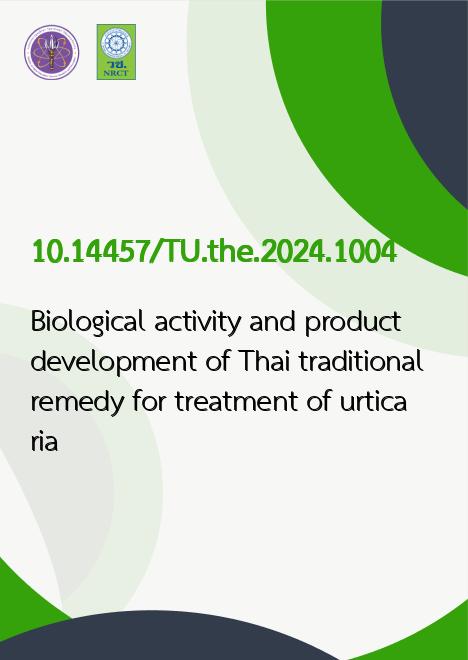| Keyword |
Urticaria, Anti-allergy, Anti-inflammation, Separation chemical, D-optimal design, Microemulsion, Stability, ลมพิษ, ต้านการแพ้, ต้านการอักเสบ, การแยกสารสำคัญ, การออกแบบ D-optimal, ไมโครอิมัลชัน, ความคงตัว |
| Abstract |
Kae-lom-pid (KLP) remedy is Thai traditional medicine that composed of four Thai herbs consisting with Allium ascalonicum L., Acanthus ilicifolius L., Bambusa blumeana Schult.f. and Rhinacanthus nasutus (L.) Kurz, that have been specified for treating urticaria as described in applied Thai traditional medicine guidelines. However, the specific plant parts for use and the biological activity evidence to support this remain undefined. Therefore, the objectives of this research were to study the effects of KLP extracts and its plant ingredients on anti-allergy and anti-inflammatory biological activities, including cytokines or chemokines related to urticaria, inhibiting β-hexosaminidase, histamine, IL-4, Nitric oxide (NO), IL-6, and TNF-α. Comparisons were made between fresh and dry materials extracted by maceration in 95% ethanol and decoction. The 95% ethanolic extracts of fresh KLP remedy (HFE) showed the highest anti-allergy activity, exhibiting inhibitory activity on β-hexosaminidase (IC50 = 56.88±19.21 µg/mL), IL-4 (IC50=48.73±0.45 µg/mL), histamine (IC50=22.84±0.40 µg/mL), and NO production (IC50=67.95±9.80 µg/mL), while showing no inhibitory effect on TNF-alpha and IL-6. The HFE also exhibited non-toxicity to RBL-2H3 cells, RAW264.7 cells and HaCaT cells, with cell viability exceeding 70%. The chemical composition and active marker of the herbal formulation KLP extracts for anti-allergy activity found from single plant extracts consist of KLP remedy. These exhibited RNDE was most effective on inhibition β-hexosaminidase (IC50=59.36±6.51 µg/mL) and IL-4 (IC50=26.85±0.82 µg/mL). The Rhinacanthus nasutus was isolated by vacuum liquid chromatography (VLC), leading to two compounds and confirmed by nuclear magnetic resonance spectroscopy (NMR) and mass spectroscopy (MS). These compound indicating Rhinacanthin-N and -C with structures were C25H30O5 and C27H24O7, respectively. Both chemical contents were remarkable in anti-allergy activity, with rhinacanthin-N being more effective than rhinacanthin-C. to inhibition of β-hexosaminidase enzyme (IC50=10.72±0.62 μg/mL and=18.38±3.16 μg/mL, respectively), inhibited IL-4 (IC50 =3.07±0.03 μg/mL and 15.32±0.55 μg/mL, respectively), inhibit histamine release (IC50=of 35.95±1.65 μg/mL and 37.65±0.47 μg/mL, respectively). Moreover, they also showed moderate inhibitor NO (IC50= 51.05±9.67 and 35.49±4.79, respectively). Both active ingredients did not inhibit TNF-alpha and IL-6 as well. However, rhinacanthin C exhibited toxicity to RBL-2H3 cells and RAW264.7 cells at a concentration of 100 µg/mL. while Rhinacanthin N was nontoxicity to these cells.The essential compounds were concentrated contained in HFE, with rhinacanthin-C 1.65±0.05%w/w and rhinacanthin N consisting of 0.20±0.01%w/w, detected by HPLC chromatograms. HFE remained stable when kept under 40±2 ºC with 75±5% RH for 6 months, which demonstrated to inhibition of β-hexosaminidase enzyme from the IC50= 51.39±10.37 to 54.26±6.76 μg/mL from day 0 to 6 months without statistical difference. The development of microemulsion products to find a substance for constructing microemulsion from solubility Rhinacanthin-C properties demonstrated IPM, surfactants such as Tween 20 and polyglyceryl-4-caprate and with co-surfactants 1,3-propanediol mixed with Isopentyldiol were selected for this formula. Detection ratio of these substances from aquas titration found Smix 1:2 ratio constructing in polyglyceryl-4-caprate mix co-surfactants (consist of 1,3-propanediol and Isopentyldiol, mixed in a 1:1 ratio) illustrated larger zone microemulsion on pseudo-ternary phase diagrams. The software design expert optimized microemulsion model comprised 5% w/w IPM, 35% w/w Smix, and 56% w/w water, which predicted particles smaller than 150 nm and transparency exceeding 90%. This formula was used to formulate a microemulsion containing KLP 1% extract. The KLP microemulsion whit appeared as a perfectly homogeneous, dark green translucent, easily flowable liquid with no observed phase separation or precipitation.Franz diffusion cell of KLP microemulsion demonstrated constant start release of Rhinacanthin-C from 30 minutes with 10.34±0.03 to 20.21±0.11% at 8 hours. Stability studies exhibited good characteristics with unchanging physical characterization and viscosity. The pH, particle size, polydispersity index, zeta potential and color values remained within an acceptable range during storage under heating-cooling conditions for nine cycles.The product KLP microemulsion was contained in a spray bottle and kept under two conditions 25± 2°C and 40 ± 2°C, 75 ± 5% humidity to find stability. They found the product had good stability when kept under 25± 2°C. Which showed an appropriate pH value around 5-6, small particle size during 150 nm, remaining PI less than 0.3, zeta potential during -40 mV and slightly increased viscosity around 1 cP. In contrast, the chemical markers were stable when kept under both conditions with Rhinacanthin-C and -N demonstrating around 0.2% and 0.02% for 6 months. In conclusion, KLP remedy was effective in anti-allergy and anti-inflammation activity, which two active ingredients were Rhinacanthin-C and -N. Therefore, these studies provide support and evidence for usage of KLP remedy to treat urticaria patients. The formula structure of KLP microemulsion was stable and can serve as a model in the pharmaceutical industry for an alternative treatment of urticaria or skin allergies. However, it is crucial to confirm its biological activity before human use. Even though fresh plants showed more effectiveness than dry plants, dry plants were also anti-allergy and anti-inflammation no less than fresh. Dry plants can be used interchangeably for safe cost and profit for industries to use and should be also evaluated by determining the stability of physical characterization and chemical content in the future. |
